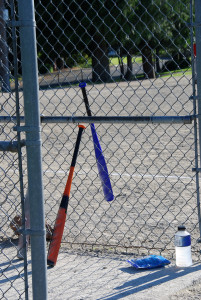by Brett Holland, PT, DPT, CSCS
Its 2015 and it is completely mind-blowing that baseball players continue to use donuts, weighted sleeves, and heavy bats in the on deck circle. Weighted bats do absolutely nothing, let me repeat that, swinging a weighted bat in the on deck circle does absolutely nothing except….make you slower and interferes with your ability to adjust to pitches.
Take a look:
Swinging a weighted bat makes you slower:
- A 2002 study found, ” Analysis of variance showed a significant decrease of 3.3% in the measured linear velocity of the bat prior to impact with the ball for the first swing of the post-Weighted condition compared with the Control condition” [1].
- A 2003 study found, “Quantitative and qualitative analyses indicated that following warm-up with the weighted bat (largest moment of inertia), swing pattern was significantly altered, and post warm-up velocity was the lowest of the three conditions“[2].
If that is not enough to deter you from picking up a donut in the on-deck circle, then take a look at how swinging a weighted bat alters your ability to make adjustments to pitches and destroys your swing pattern.
- From above , “Quantitative and qualitative analyses indicated that following warm-up with the weighted bat (largest moment of inertia), swing pattern was significantly altered“[2].
- A 2014 study found, “It is suggested that weighted bat warm-up decreases the adjustment ability associated with inhibition of muscle activation under movement correction conditions”[3].
- A 2012 study found, ” When participants needed to correct their swings to the target’s velocity change, larger timing errors were produced in the weighted than in the normal practice condition. These results indicate that warm-ups with a weighted tool create adverse effects for the movement (re)programming processes in interceptive action. This suggests that warm-ups with a weighted tool for an interceptive task affect the central nervous system and not the peripheral system”[4].
What is a good warm-up for the on-deck circle:
Although there is some evidence swinging a lighter bat produces an increase in velocity, I am reserved to recommend this due to the potential negative effects it might have on timing.
Here is my on-deck circle recommendation:
- 1-4 explosive maximal isometric pushes into a flat surface (wall or padded backstop) hold for 3-5 seconds. Push should be right prior to contact. Without causing fatigue.
- A few maximal standard bat swings without causing fatigue.
- Mental imagery of the pitcher and making solid contact
Why an isometric push?
Explosive maximal isometrics do a few things:
- excite the nervous system (this is called post-activation potentiation)
- they avoid interfering with timing
- they may increase bat speed (iso=isometric)
- a 2013 found, “A post hoc paired t-test showed that there was (a) no significant change in post-SBS BV (−0.33 m·s−1, or −0.73 mph), (b) a significant decrease in post-WBS BV (−0.89 m·s−1, or −1.98 mph; p < 0.05), and (c) a significant increase in post-ISO BV (+0.39, or +0.86 mph; p < 0.05)“[5].
References
- Otsuji, Tamiki, Masafumi Abe, and Hiroshi Kinoshita. “After-Effects Of Using A Weighted Bat On Subsequent Swing Velocity And Batters’ Perceptions Of Swing Velocity And Heaviness.” Perceptual and Motor Skills 94.1 (2002): 119-26. Web.
- Southard, Dan, and Levi Groomer. “Warm-up with Baseball Bats of Varying Moments of Inertia: Effect on Bat Velocity and Swing Pattern.” Research Quarterly for Exercise and Sport 74.3 (2003): 270-76. Web.
- Ohta, Yoichi, Yasumitsu Ishii, Sachi Ikudome, and Hiroki Nakamoto. “Warm-Up With Weighted Bat And Adjustment Of Upper Limb Muscle Activity In Bat Swinging Under Movement Correction Conditions 1 , 2.” Perceptual and Motor Skills 118.1 (2014): 96-113.
- Nakamoto, Hiroki, Yasumitsu Ishii, Sachi Ikudome, and Yoichi Ohta. “Kinesthetic Aftereffects Induced by a Weighted Tool on Movement Correction in Baseball Batting.” Human Movement Science 31.6 (2012): 1529-540. Web.
- Higuchi, Takatoshi, Tomoyuki Nagami, Nobuaki Mizuguchi, and Tim Anderson. “The Acute and Chronic Effects of Isometric Contraction Conditioning on Baseball Bat Velocity.” Journal of Strength and Conditioning Research 27.1 (2013): 216-22. NSCA. Web.

